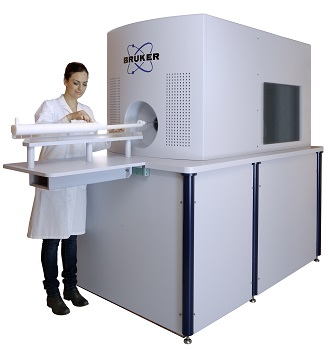At the 2013 World Molecular Imaging Congress (WMIC), Bruker today announced the world’s first Magnetic Particle Imaging (MPI) system, an entirely new technology for preclinical imaging.
The addition of MPI as a complementary preclinical imaging technique for disease studies, translational research and drug discovery, has significant potential in helping researchers gain new insights into disease processes at the organ, cellular and molecular level.

The new Bruker preclinical MPI scanner was developed in collaboration with Royal Philips (NYSE: PHG, AEX: PHIA), in a partnership that combines Bruker’s leadership in analytical magnetic resonance instruments and preclinical Magnetic Resonance Imaging (MRI) with Philips’ strengths in medical imaging. With MPI, Bruker has further expanded its fast growing preclinical imaging product portfolio that includes MRI, PET, SPECT, micro-CT, optical molecular imaging, X-ray, and now also MPI.
MPI is a new medical imaging technology that was invented and developed by scientists at Philips and a proof of principle was first published in the Journal Nature in 2005. The MPI tomographic imaging technique relies on the detection of the magnetic properties of iron-oxide nanoparticles injected into the bloodstream to produce three-dimensional images. The potential of the technology for medical and industrial research and, ultimately, patient care, has been demonstrated in several studies, e.g. MPI technology has been used to produce real-time images that accurately capture the activity in the cardiovascular system of a mouse. Indeed, the ability to acquire high time-resolution images in a matter of milliseconds, allows for novel applications in which temporal resolution is able to resolve questions not addressed by many existing imaging techniques.
Dr. Michael Heidenreich, Technical Director of Bruker BioSpin MRI, stated: “We are very pleased about this breakthrough in preclinical imaging and our collaboration with Philips on this exciting technology. Magnetic Particle Imaging is a novel imaging modality that is expected to enable scientists to address an extensive range of new issues in preclinical research. MPI nicely complements Bruker’s preclinical imaging product portfolio of now nine different modalities. The highly sensitive visualization of functional characteristics in vivo at high temporal resolution offers great potential for small animal imaging, especially when combined with high spatial resolution morphological MRI.”
"Magnetic Particle Imaging represents a fundamentally new imaging modality with an exceptional ability to image in vivo functional behavior," said Homer Pien, Chief Technology Officer at Imaging Systems, Philips Healthcare. "We are particularly excited about its potential for providing new insights into cardiovascular disease, cancer, and stem cell therapies. Going forward, I am convinced that the results from the research studies conducted with preclinical MPI systems will provide valuable guidance for our ongoing development of a whole-body clinical MPI system."
As part of the collaboration, Bruker and Philips will co-market the new preclinical MPI scanner.